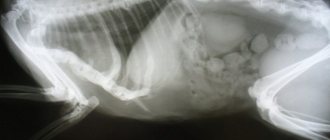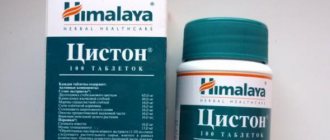Causes
Causes and factors of cystitis in cats:
- Kidney diseases (pyelonephritis and glomerulonephritis can also occur in cats)
– in this case we are talking about the descending nature of the infection.
- Ascending infectious processes - they are usually associated with hypothermia.
- Infection by hematogenous or lymphogenous route.
Both male and female cats suffer from cystitis. But manifestations of the disease in cats are more common. This is due to the anatomical features of the body. In cats, the urethra is wide, straight and short, which means salts are almost freely excreted in the urine. The urethra of cats is longer, has narrowings and bends, therefore, mucous and salt plugs often appear in it, blocking the release of urine (obstruction).
Castrated cats, whose genitourinary system functions differently than those of non-castrated cats, are more predisposed to cystitis. Stagnation of blood in the genitals leads to swelling, and this leads to spasms and urinary retention, stagnation in the bladder, salt loss, urolithiasis and chronic cystitis.
In the practice of veterinarians, it is noted that the spread of the infectious process does not matter - the principles of treating cystitis are always the same.
The main thing is to diagnose the disease in time, since it is much easier to be treated in the early stages . But there are problems with this - a pet will not complain to you like a human. Therefore, when treating animals, early diagnosis is difficult.
How does cystitis manifest? Signs and symptoms
The most characteristic symptoms of cystitis are pain when urinating and frequent urge . You will see how a domestic cat, having gone “to do a little need”, will make plaintive sounds and angrily scratch the “toilet” with its claws.
Be sure to pay attention to the nature of the discharge - with cystitis (especially with severe manifestations of this disease), bloody discharge, impurities of pus, and a foul odor may appear in the urine.
This is what a sick cat looks like
If you suspect cystitis in cats, you must definitely palpate the stomach - in the case of an acute form of the disease, the animal will feel a sharp pain in the lower sections (when you press on the cat’s stomach, the area located closer to the tail will hurt).
Regarding the characteristics of the course, the disease has an acute and chronic nature. But, in any case, this disease is very dangerous for the life and health of the animal, since the possibility of extensive damage to the organs of the urinary system cannot be ruled out.
In addition, the owner must not forget that microorganisms that cause cystitis in cats can cause inflammatory processes in the urinary system in humans.
Important Note
– owners of cats who prefer to take them outside are less likely to detect symptoms in their pets in time (since the cat “walks on its own” outside). In this case, it becomes clear that something is wrong with the animal only when the cat is already lying down and meowing pitifully, without expressing any desires.
In later stages of the disease, all the symptoms are accompanied by signs of intoxication syndrome - a characteristic increase in the animal’s body temperature (measured only rectally), as well as severe vomiting.
If swelling can be noticed on the paws, this indicates that nephrotic syndrome has developed - a sign indicating damage to the lower and upper parts of the urinary system.
In this case, you need to urgently hospitalize the animal - otherwise death is guaranteed.
Diagnosis of bladder inflammation
The symptoms described above may not be noticeable in all cases. It also happens that a cat does not show any signs of the inflammatory process (this is the complexity of the diagnostic algorithm in veterinary practice - you can find out from a person what is bothering him - but in the case of animals this is impossible).
Sometimes it is necessary to make a diagnosis based on instrumental and laboratory research methods:
General blood analysis
– characterized by an increase in the level of leukocytes, a band shift to the left, an increase in ESR. Signs of an infectious-inflammatory process. General urine analysis
– pronounced changes, consisting of proteinuria, cylindruria, leukocyturia, increased relative density and darkening of the color of urine. It is imperative to culture urine for sterility and determine sensitivity to the antibacterial drugs used - this will allow the most effective treatment to be prescribed. Biochemical blood test with determination of the renal-hepatic complex.
By carrying out this analysis, you can verify not only how intense the pathological process is, but also whether the kidneys themselves are affected by the inflammatory process and, if so, how intensively the process has developed. Ultrasound examination of the bladder and kidneys
This study allows you to accurately determine the cause of the inflammatory process - ultrasound shows what causes the inflammatory reaction (are there morphological disorders, such as the formation of stones).
Cost of tests at the Univet veterinary clinic
Diagnosis is the same as for humans, only the results of the studies are assessed according to different criteria. All this is done only in a veterinary clinic.
Answers to questions from an online veterinarian. Free consultations
Should the doctor replace it with something? We are afraid that the cat will not live to see the end of the course....Thank you
↓↓0↑↑ Elena (-9 / 3) July 27, 2014 23:43 »»
Hello, Elena. Very similar to an overdose, which leads to a strong increase in the tone of the smooth muscles of the internal organs. It is urgent to discuss with your veterinarian the possibility of taking another anticholinesterase drug or reducing the dosage of proserin. It must be said that adequate dosage is of decisive importance.
Insufficient - has no effect, and high can lead to serious consequences. If you suspect that your cat has any pain, you should not give it Proserin until the pain syndrome is relieved (in the acute phase of the disease, the drug is strictly contraindicated). By the way, the drug injections themselves are very painful.
We suggest you read: What happens if a cat eats a poisoned mouse - what to do if a cat is poisoned by a mouse?
↓↓0↑↑ Orlova Svetlana Arkadyevna (1557 / 2266) July 28, 2014 08:52 ““#2”” Reply
you know, although I’m not a doctor, I intuitively understood that she was getting worse and worse with each injection (!), especially since there were from 5 to 6 of them at a time (decamethasone 1.0, riboxin 1.0, pirocetam 1.0, thiotriazoline 1.0, proserin 0.3 (reduced only on the 5th day from 0.5 mg!), glucose 5% 20.0 This is a prescription for injections on the 8th day of treatment - the day of her death…….
(and the diagnosis was already not myelopathy, but encephalopathy) all that day she was throwing around from pain and convulsions (the injections were given by 17.00) the cat was in great pain, screaming, severe convulsions... I thought that I would lose consciousness from her torment... if we were still on July 27 and 26 They injected her at 11.00 (like the whole course from July 21), then by the evening she felt at least a little better, she at least somehow reacted to us and even ate well (until July 26).
Do you know that the most interesting thing all started with the fact that she was limping on her leg, and seemed to be clinging to the floor with her claws, slightly... (it was like this for 2 weeks, we waited, maybe it would get better, you never know) But no, so we went to doctor, we were prescribed this course (listed above, plus or minus some injections were changed) AND IMMEDIATELY THE NEXT.
THAT DAY SHE WASN’T ABLE TO GET UP, at first she crawled, and by the evening she was already rolling around, after a couple of days she was lying almost all the time... well, then you know (ps. the picture of the spine was excellent)... we were crying a lot 28.07 by 20.15 she was gone, I didn’t even have time to call intensive care... because the pulse was 34 beats... it was easily visible and palpable on the neck....
I saw my husband cry for the first time...she was only 1 year and 11 months...Perhaps our experience can save other beloved pets...P.S.: we did not have time to read your answer...although we consulted with more than 5 veterinarians , everyone unanimously approved of such treatment....is this illiteracy???or heartlessness...
↓↓0↑↑ Elena (-9 / 3) July 30, 2014 00:06 ““#3”” Reply
I will decide for myself what is necessary and what is not - it is not sensitive on your part. But not everyone manages to find an adequate doctor with adequate treatment on time!
↓↓−9↑↑ Elena (-9 / 3) July 31, 2014 20:56 ““#5”” Reply
I couldn’t pass by. How shameless of you. They try to help you, give you advice, but you answer ungratefully with jargon, one might say show off. It’s wiser to pass by if you don’t like it. People spend time on us, invest their souls. It's no one's fault that this happened. I am very sorry about what happened to the cat, I love animals very much. PS: It would be nice to improve your grammar. Good and healthy.
↓↓ 5↑↑ Giorgio Armani (12 / 47) 01 Aug 2014 04:14 ““#6 Reply
Atony in cats is a disease that is characterized by a lack of normal tone of the skeletal muscles or internal organs, which leads to disruption of their normal functioning.
With this pathology in animals, muscle elements stop contracting vigorously. Despite the fact that this disease is not common in veterinary practice, without normal contraction of smooth or striated muscles, like any other living beings, they cannot move normally, obtain food on their own, or perform many other actions.
Principles of treatment and prevention of cystitis in cats
It should be noted that the treatment of cats with cystitis is not much different from the therapeutic approaches of human medicine and can occur at home.
The most important point in treating a disease is the destruction of the pathogenic microorganism
.
This is achieved with the help of antibacterial drugs - in this case they are taken: cephalosporins (ceftriaxone, cefoperazone) or fluoroquinolones (levofloxacin, ciprofloxacin). The recommended frequency of administration is twice a day with an interval of twelve hours (the recommended schedule is 8 am and 8 pm). The dosage is calculated purely individually, depending on the severity of the animal’s condition, age and body weight.
In addition, be sure to use uroseptics - they complement the action of antibacterial drugs, thereby potentiating the therapeutic effect. Furagin, furamag or furazolidone are used. Taken morning and evening, preferably before meals. You can use feed additives (“Stop-Cystitis”) to normalize and improve the functioning of the urinary system.
Don't forget about probiotics. Linex, Lactovit or yogurt are taken three times a day, otherwise the cat will have to be treated for dysbiosis.
Treatment of bladder atony in cats
The therapist advised us to contact a neurologist, who suggested that we take prednisolone along with proserin (on the 27th day of taking proserin, i.e. from April 20), explaining that it relieves swelling, in a dosage reduced from 30 mg to 5 mg. At the same time, reduce proserin. This helped us, he began to walk twice and we left prozerin and started giving only prednisolone tablets. For three weeks the cat walked little by little, twice a day on 1.5 tablets. prednisone. When we tried to reduce it to 1 tablet, he began to walk once and the doctor said to increase it back to 1.5. On May 21, the cat did not go to the toilet at all. We took 0.1 proserine for 2 days along with 1.5 prednisolone. We visited a therapist who did an ultrasound and said that according to the ultrasound everything was more or less normal, we took a urine test, where protein = 300 (before that it had always been at 30), and the therapist said that we should try not doing anything at all, remove proserin, reduce gradually prednisolone (because she said we can’t have prednisolone due to kidney failure) and wait up to two days for the cat to go to the toilet on its own (apparently she wants it to be like this all the time). But I read everywhere and the neurologist tells us that two days is a lot, toxins are released and here we have to choose from two evils - either the load on the kidneys due to drugs, or due to contamination of the blood and the whole body with toxins from stagnant urine, the possibility of overstretching the urinary tract bubble The neurologist said that the cat may have chronic outbreaks of cystitis, and prescribed to continue prednisolone 1.5 tablets and add a two-week course of antibiotics - 5-NOK, then take tests and see the results. I’m already completely confused and can’t figure out how to help the cat and not harm it. I understand that it is vitally important to write regularly, but at the same time I am afraid for my kidneys. I have doubts about the first doctor who says to wait for two days, and I began to doubt him when today I discovered a contradiction in his prescriptions: since December we have been taking Amprilan (as I understand it to support the heart, because it old), but according to the instructions Amprilan is contraindicated in case of renal failure. And the second doctor, knowing about kidney failure, offers us only Prednisolone, as I understand it, also for life, although I admit that it had an effect. What treatment is more appropriate, how can we cure the cat and restore regular urination? Are there any other alternatives to these drugs? Tomorrow we will take a blood biochemistry test for urea and creatinine (as the neuropathologist said, to identify the consequences of prednisolone therapy and the condition of the kidneys), according to the latest test at the beginning of April, urea was 12 with a normal range of 5-11, creatinine was 207 with a normal range of 90-180. I post the results of the latest urine tests on May 20:
I really hope for your advice and points of view. The cat has been with me since childhood, we grew up together, I am sincerely very worried about him.
22.05.2013 22:44We suggest you familiarize yourself with: Prazicide suspension for kittens
Proserin, should it be replaced?
Tell me, our cat has a pinched nerve, she doesn’t walk, the doctor prescribed medications, including: Prozerin. On the 6th day the cat had terrible vomiting, on the 7th the same vomiting in the morning and evening, she no longer eats anything, only drinks water, muscle twitching was there all the time, but today it was especially painful for her, she constantly licks her lips... But the doctor says that she should stop it is impossible because This is the main drug.
Features of the disease
With cystitis, the inflammatory process affects the inner surface of the bladder. It can occur in any cat and is completely unrelated to the breed, gender or age of the animal. This disease has its own specific characteristics:
- It can occur in an acute form, accompanied by pronounced symptoms. But sometimes it turns into a chronic (protracted) form, and then the clinical picture is blurry and ambiguous.
- There are several forms of inflammation, but more often in cats they are diagnosed with serous-catarrhal, hemorrhagic, and purulent. There is another classification of the disease, when a specialist focuses on the main clinical signs, taking into account the assessment of impurities in the urine: serous-catarrhal (presence of cloudy mucous inclusions in the urine), purulent and hemorrhagic (bloody impurity) cystitis.
Symptoms of cystitis in cats are similar to signs of urolithiasis. For this reason, only a veterinarian can make an accurate diagnosis, based on additional research.
The cat stopped going to the litter box, what should I do?
Urinary incontinence in cats is divided into several types, according to the nature of the manifestations:
- The cat's urine is constantly flowing in small drops. The cause of this disease is a weakening of the muscles that control the sphincter. Another reason is weak bladder muscles that are unable to stretch and contract.
- The inability to tolerate is called urge incontinence. Urine excretion occurs spontaneously as soon as the pet feels the urge. Such animals do not have time to reach the tray, but strive towards it.
- Stress incontinence has nothing to do with psychological stress. This refers to a sharp increase in pressure in the abdominal cavity, which leads to urination. In such animals, discharge can occur, for example, from a sharp jump.
- Reflex discharge occurs when the pet does not feel the urge to pee. Emptying occurs reflexively.
- Nocturnal inability to hold urine, as the name suggests, occurs at night when the pet is sleeping and cannot control the urge to pee.
If there is any suspicion of a disease, the owner should contact a veterinarian.
Obvious symptoms of the disease
The owner should be alarmed by changes in the pet’s behavior and some symptoms indicating the development of the disease:
- The cat visits the litter box too often to pee. Sometimes your pet fails to do this and leaves puddles all over the house, even on his own bed or on the way to the toilet.
- The urge when the bladder becomes inflamed becomes constant, and even after emptying itself, the cat can go back to the litter box. In this case, urine most likely will not be released. And this is already a very alarming sign.
- When the urge occurs, strong, cutting pain occurs in the affected organs, and the pet will “scream” loudly.
- The color of the urine changes. It becomes dark, cloudy, perhaps the appearance of bloody impurities or mucous flakes, sand and small, barely noticeable stones. The latter manifests itself if urolithiasis is added to cystitis.
- If a purulent process occurs, the urine acquires a pronounced putrefactive odor.
- A significant increase in body temperature, up to critical levels, is possible with acute inflammation. In chronic cystitis, this symptom may not be present, or the increase may be low-grade if the inflammation is sluggish.
- During a fever, the cat has no appetite and does not drink.
- The animal becomes lethargic, inactive, and lies in a lying position most of the time. He may often caress, as if he wants to warm up, but does not allow his tummy to be touched.
- The cat reacts sharply to touching the abdomen, since these actions are painful for him and cause a feeling of fullness. Due to pain, the pet does not lie on its stomach, and the position on its side is accompanied by significant discomfort.
If, against the background of inflammation, the animal’s paws swell, then this is a sign of the development of nephrotic syndrome. It occurs when the upper and lower parts of the urinary system are affected. But if the cat “in an interesting position” began to often run to the litter box, then perhaps the problem is not inflammation, but an increase in the size of the uterus, pressing on the bladder. And if there are no other symptoms and the expectant mother is calm, then there is no reason for alarm.
Main causes of bladder inflammation
There are many reasons why this organ becomes inflamed, but most often this occurs due to:
- entry of a bacterial pathogen into the bladder as a result of an infectious disease, weakening of the immune system;
- dehydration of the body;
- diabetes mellitus;
- helminth infections;
- injury to the urinary ducts and internal organs, for example due to a bruise or fall;
- weakened immunity;
- hypothermia;
- formation of stones in the bladder.
Provoking factors.
Even a stressful situation can provoke an inflammatory process in the organ cavity - a change of place of residence, separation from a loved one, the appearance of a new member or pet in the family.
Who is at risk? There is a category of mustachioed striped animals, especially prone to cystitis:
- Pets with poor health – those who have had an illness or surgery, newborns and elderly animals. Their body is not able to fully resist any infectious pathogens, and even slight cooling can lead to inflammation.
- Females are diagnosed with cystitis more often than males.
- Animals that have not undergone castration (sterilization) develop cystitis less often. Experts attribute this to a weakening of the body’s immune forces and the risk of infection during surgery or during the healing period.
Paralysis and paresis of the bladder
Paralysis and paresis of the bladder (Paralysis et paresis vesicae urinariae) is a temporary or permanent loss of the ability of the muscular wall of the bladder to contract.
This disease occurs in all animal species.
Etiology . Damage to the bladder, accompanied by reduced contractility, or even complete loss of the bladder to contract, occurs in animal diseases associated with damage to the central nervous system (meningitis, encephalitis, encephalomyelitis) or as a result of damage to the caudal part of the spinal cord (myelitis, contusion, compression and etc.).
How to help an animal
The best thing an owner can do for his sick pet is to take him to a veterinary clinic. If this cannot be done right away, then you can give him the drug Papaverine, and even more effectively do subcutaneous or intramuscular injections. The daily dose of the drug is 1-2 mg per kilogram of animal body weight. Papaverine will reduce the pain caused by spasms.
In addition, you can drink the cat with infusions of medicinal herbs. The rest of the medications for cystitis are available by prescription, which means you cannot do without consulting a specialist.
Diagnostics
To make a diagnosis, it is necessary to carry out diagnostic measures with the obligatory identification of the cause of inflammation. The examination includes:
- Examination by a veterinarian who collects a medical history and assesses the patient’s condition.
- Palpation of the abdomen and bladder.
- Blood test, since it is important for the doctor to know the increase in white blood cell levels. The veterinarian determines whether there is an infection in the cat's body or not. Monitors the ESR indicator.
- General urine analysis. This laboratory test reveals the presence of bloody impurities and changes in the color, number of red blood cells and casts.
- Culture for sensitivity to antibacterial drugs.
- Biochemical blood test - prescribed to determine hepatic-renal complexes. Allows you to assess the overall picture of damage to the urinary system.
- Ultrasound helps determine the extent of the lesion and detects additional tumors.
Diagnostics and therapy
Only a veterinarian can correctly diagnose the disease. After a complete examination and palpation, he will prescribe urine and blood tests, as well as an ultrasound of the abdominal organs. Once the diagnosis is confirmed, it is necessary to ensure that the urine is removed. Until this procedure is completed, the animal’s body continues to become intoxicated.
In some cases, a catheter is placed to drain urine from a full bladder. Be prepared for the fact that the doctor may perform the procedure under general anesthesia.
An advanced disease and untimely treatment can result in a ruptured bladder, and as a result, the death of the pet.
Drug treatment should be prescribed only by a qualified veterinarian, taking into account all the individual characteristics of your cat, the severity of the disease, the presence of additional symptoms, and the severity of the animal’s condition. You cannot self-medicate! Within a day, the disease can develop to a severe form and cause death.
Treatment of cystitis
Therapy for this disease solves several problems at once:
- Relieves spasms, eliminates pain - for this, antispasmodics and analgesics are prescribed.
- Neutralizes the cause of the inflammatory process and suppresses bacterial pathogens - correctly prescribed antibiotics can cope with this problem.
- Cleanses the inflamed organ from pathogenic contents - for this, liquids that have an antiseptic and antibacterial effect are introduced through a catheter.
- Eliminates dehydration - the animal is given IVs.
About feeding and caring for a sick animal
To minimize the load on the kidneys and normalize the urination process, you should remove the food and give the cat the opportunity to drink as much as he wants. Abundant fluid is necessary to naturally “flush” the bladder. If the urethra is not blocked, then you can speed up the removal of inflamed fluid from the cavity by giving the cat decoctions of medicinal plants:
- corn silk;
- bear berries;
- knotweed;
- kidney grass;
- steelweed rhizomes;
- pusher, etc.
If your pet doesn’t make it to the toilet and leaves puddles and wet spots everywhere, then you can dress him in a special diaper. One more thing: cystitis requires nutritional correction.
When feeding your pet with ready-made diets, it is recommended to switch it to special menus intended for animals with urological disorders, for example, Royal Canin Urineri S/O.
Effective medications for cystitis
After normalization of urine outflow, it is necessary to wash the bladder and canal with antiseptic solutions: potassium permanganate, 0.9% saline solution, orthoboric acid, Ichthammol. This procedure will free the urethral and bladder cavities from mucous accumulations, small stones, bloody clots and other particles.
If, during the diagnostic process, obstructive changes in the patient’s tissues are revealed, then retrograde urohydropuslation, installation and attachment of a tube to the bladder for 5-7 days may be required. When the outflow of urine is restored, specialists carry out symptomatic treatment:
- They relieve the inflammatory process and eliminate the activity of toxins.
- Pain relief.
- Relieves electrolyte imbalance.
- To eliminate intoxication processes, droppers or subcutaneous injections of Ringer's solution are prescribed.
- If an animal is diagnosed with acute bacterial cystitis, then after titration, it is prescribed a course of antibiotics: Baytril, Ceftriaxone, Cobactan, as well as drugs from the sulfonamide class: Furagin, Furosemide, children's Biseptol. The duration of antibiotic therapy can be 3-4 weeks.
- To normalize the microflora and get rid of the side effects of antibiotics, the cat is prescribed drugs from a number of enterosorbents, probiotics, etc.
- To relieve spasms and colic, the cat is prescribed antispasmodics, which are administered by injection: No-shpu, Travmatin, etc.
- If the disease is accompanied by bleeding, then the drug Dicinon is included in the therapy.
- Homeopathic remedies are used as additional help: Cantaren, Nux Vomica, Urtica Urens, etc.
- In order to restore immune function, the animal is given immunocorrectors.
Stop cystitis for cats
According to most veterinarians, this is one of the most effective combination antimicrobial drugs. They produce two types of drugs:
- Stop-cystitis – contains a plant complex and synthetic components. The drug eliminates the inflammatory process, relieves spasms, relieves pain, and accelerates the excretion of urine. The medicine also suppresses microbial flora. It is included in treatment and is recommended to be given to the pet to prevent the development of a pathological process.
- Stop Cystitis Bio is a dietary dietary supplement consisting only of plant ingredients. It is recommended to give it to your pet to maintain and normalize the functions of the urinary system. The substances of the drug improve the excretory properties of the kidneys, help cleanse the system of toxins, prevent the deposition of salts and the formation of stones. This remedy is used only as part of complex therapy to eliminate the main causes of inflammation.
Contraindications and side effects. Stop cystitis has some contraindications. For example, it is not given to animals with impaired cardiac function, vascular function, or renal failure. But the drug Bio does not have such conditions for administration. Stop Cystitis has no side effects other than those caused by the body’s individual reaction to the components. There is also no information about the serious consequences of an overdose.
Also watch the video of cystitis in cats:
Ways to prevent the development of inflammation
Cystitis is a common cat disease, so owners of furry pets better be careful and not forget about basic preventive measures:
- It is important to ensure that your pet is not overcooled or in a draft.
- Dangerous situations leading to injury to the animal should be avoided. After all, bruises of the peritoneum often lead to internal inflammation.
- Even if the cat does not cross the threshold of the house, it needs antiparasitic treatments and taking anthelmintic drugs.
- Give high-quality food; it is recommended to adhere to the dosage and meal regimen.
- Vaccination is another measure necessary for the healthy life of an animal. Feline herpes, calcivirosis, feline distemper and rabies are dangerous diseases for which cats should be vaccinated against. Depending on the epidemiological situation in the area where the cat lives, additional vaccinations may be required. Vaccines should be given from the age of 9 weeks, after deworming the pet 1.5-2 weeks before the procedure.
If the cat is already suffering from a chronic form of the disease, you should monitor its condition more closely, reacting at the first signs of cystitis. Naturally, in this case, preventive measures require even more attention.
A person who has encountered the symptoms of cystitis at least once can fully understand how an animal suffers from this disease. Therefore, you should not wait for your pet’s condition to worsen and it is better to immediately seek professional help. And if the cat starts going to the toilet more often, the owner needs to be wary.
Causes of the disease
The cause of the disease can be external and internal factors. The first group includes hypothermia, infection, helminthic infestation, trauma, stress, etc., and the second group includes hormonal imbalance (metabolic disorders, problems with the genitourinary system, the presence of chronic foci of infection in the animal’s body).
Cats are susceptible to inflammation of the bladder mucosa, regardless of age, gender and breed. This is due to the peculiarities of the drinking regime and the high risk of hypothermia and urinary tract injury.
- Hypothermia. Hypothermia is one of the most common causes of cystitis. If your cat walks outside, sleeps in a drafty room, or has a habit of lying under an air conditioner, in a bathtub, on tiles or on a windowsill, she is at increased risk.
- Infectious diseases. The penetration of a bacterial, viral, fungal or other infection is the main cause of cystitis in animals. Hypothermia, decreased immunity and endocrine disorders only create favorable conditions for the proliferation of pathogens. The infection can enter the bladder through ascending, descending and hematological routes (from the urethra, kidneys and other foci of inflammation, respectively).
- Chronic cystitis in cats. Chronic cystitis is often a complication of untreated acute inflammation or other diseases of the urinary tract. Inflammation and damage to the walls of the bladder can occur with kidney failure and urolithiasis. The genitourinary system also suffers from pathologies of the liver, gall bladder and bile ducts.
- Metabolic disease. Disruption of metabolic processes in the body and hormonal imbalance can cause decreased immunity and stagnation of urine. This facilitates the development of infection and prevents the rapid removal of microbes from the urinary tract. An animal's hormonal levels may change after sterilization or castration. After removal of the testicles, cats are at increased risk of developing urolithiasis (UKD), so they need to undergo regular preventive examinations with a veterinarian and undergo a urine test.
What is it for
A long absence of urination with preserved kidney function leads to the accumulation of urine in the bladder, its overstretching and, in the most severe cases, rupture of the wall, which soon leads to the death of the animal. In a simpler case, there is a sequential expansion of the ureters, calyces and renal pelvis, compression and atrophy of the renal parenchyma.
The attached microflora provokes the development of infectious complications:
- Urethritis.
- Cystitis.
- Pyelonephritis.
- Infectious-toxic shock.
- Sepsis.
Prolonged stagnation of urine causes sedimentation of salts , leading to the formation and growth of stones in the urine collector.
If the stone is large, it is possible to develop a bedsore of the bladder wall, perforate it and cause the death of the animal. A feature of the urinary canal in cats is the S-shaped bend of the urethra. The external urethral sphincter is located in this zone, so the lumen of the canal has a relative narrowing. Pain in the urethra during the discharge of uroliths can cause a reflex spasm of the sphincter. The combination of such anatomical features leads to a common problem in cats - obstruction of the urethra with urinary stones and acute urinary retention.
Symptoms of the disease
When cystitis develops in a cat, the following phenomena may become symptoms of the pathology:
- Unusual pet behavior. A sick animal is anxious, often licks its belly and genitals, and meows loudly when going to the toilet. The cat becomes less playful; due to pain in the lower abdomen, he tries to move less and looks for a secluded place.
- Changes in the nature, intensity and frequency of urination. Due to spasms of the bladder, the animal begins to frequently go to the tray, and the amount of urine released decreases. Urine comes out in an uneven stream and in small portions, in the most severe cases - in drops. In the process of urinating, a sick cat arches its back, strains and strains, meowing loudly. Due to pain in the urethra, the animal may avoid the tray and urinate in places not intended for this.
- The presence of foreign impurities in urine. Due to the large number of leukocytes and epithelium, urine with cystitis becomes cloudy, and waste products of pathogenic microorganisms give it a sharp, unpleasant odor. In some cases, there may be traces of blood or pus in the discharge. The cause of the appearance of blood in the urine during cystitis can also be the presence of a primary disease - oncology or urolithiasis.
- Signs of intoxication. With a descending route of infection or a complication of cystitis with pyelonephritis, the cat’s body is poisoned by waste products of pathogens. Against the background of inflammation, lethargy, weakness of the animal, loss of appetite and interest in treats, diarrhea and periodic vomiting occur.
With cystitis in cats, the symptoms are no different.
Some manifestations of the disease are difficult to track due to an erased picture of the pathology or extraneous factors (for example, the use of wood and scented litter for the tray). In order not to miss the onset of inflammation, you need to pay attention to your pet’s behavior.
A method for determining illness in a cat by its posture.
It is difficult to make a correct diagnosis on your own, because... the clinical picture of cystitis is similar to the symptoms of pyelonephritis, urolithiasis, nephrosis and other pathologies.
For differential diagnosis, an in-person examination of the animal by a veterinarian, general urine and blood tests, and ultrasound of the kidneys and bladder are required. In some cases, additional studies are carried out: blood biochemistry analysis (renal and liver tests), radiography of the urinary organs and cystoscopy.
Symptoms
When atony of the intestines or stomach in animals, disturbances in digestive processes are noted. Pathology manifests itself:
- frequent debilitating vomiting;
- loss of appetite, refusal of food and favorite treats;
- lethargy, decreased activity, weakness;
- loss of body weight;
- unstable stool (diarrhea, constipation);
- acute pain on palpation of the abdomen, tight tummy;
- deterioration of coat condition.
Some cats have an increased appetite, but at the same time the daily number of bowel movements decreases, which can cause severe intoxication of the body. The act of defecation is difficult, cats experience pain when visiting the litter box. Mucous membranes are icteric, anemic.
We suggest you read: Dachshund hair loss -2. Why does a dog lose hair in winter?
With atony of the bladder, the symptoms are mainly manifested by difficulty urinating. There may be flakes, blood clots, and bloody threads in the urine. The rest of the symptoms are the same as with atony of the gastrointestinal tract muscles.
How to treat a pet
Treatment of cystitis in cats at home is possible only after all the necessary diagnostic tests have been carried out and drug therapy has been prescribed.
The course of treatment includes:
- symptomatic therapy (antispasmodics, analgesics);
- antimicrobial drugs and herbal uroseptics;
- medicines for the correction and treatment of the underlying pathology;
- diet and proper drinking regimen.
Before contacting a veterinarian, no medications should be given to a sick pet. If the pain is severe, you can administer a dose of antispasmodic to the cat, calculated according to the weight of the animal. You should inform your doctor about this at your appointment.
Injections for a cat
The preferred form of administration of painkillers and antimicrobial drugs is injections. Parenteral administration ensures the required concentration of active substances in the body, a quick effect and the absence of complications from the gastrointestinal tract.
The following medications are administered to cats in the form of injections:
- antispasmodics (No-shpa, Papaverine);
- analgesics (Baralgin, Analgin, Revalgin);
- antibiotics (Gentamicin, Amoxiclav, Levomycetin);
- immunostimulants (IBS).
Antimicrobial agents should be given in a course, without stopping therapy at the first signs of relief in the cat’s condition.
The following medications may be prescribed for oral administration:
- Salol;
- CatErwin;
- Stop cystitis;
- Canephron;
- Cyston;
- Cantaren;
- probiotics (Lactovit, Bifitrilak).
Traditional methods of treatment
Treating a cat without the advice of a veterinarian is very dangerous, because... this can lead to chronicity of the disease and the development of complications in the kidneys.
Step-by-step treatment plan.
With the permission of the doctor, symptomatic therapy can be supplemented with infusions and decoctions of the following plants:
- plantain, bearberry, birch, lingonberry, nettle (leaves);
- cinquefoil;
- horsetail;
- chamomile (flowers), etc.
CatErwin or Stop-cystitis: which is better?
KotErwin are anti-inflammatory and mild diuretic drops that contain extracts of knotweed (field and kidney), horsetail and steelhead root. This drug is best suited for the prevention of urolithiasis and urological syndrome.
Stop-cystitis contains both herbal components (extracts of juniper, lingonberry and birch leaves, nettle, knotweed and licorice root) and medicinal preparations (antibiotic nitroxoline and antispasmodic drotaverine). It comes in tablet form and is suitable for the treatment of bladder inflammation.
Stop Cystitis Bio contains only herbal ingredients and is suitable for the prevention of cystitis in cats.
Treatment of a sick pet
Cystitis in cats can have several types, differing in the intensity and duration of symptoms. The initial phase of cystitis is best treated; in the chronic form, it is quite difficult to get rid of the disease for good. There are also forms of bladder inflammation such as hemorrhagic and idiopathic.
The acute form of the disease is characterized by the rapid development of an inflammatory process, in which the cat becomes irritable, experiences pain in the bladder or urethra, and does not have time to reach the litter box. Signs appear within a few hours after the infection enters the urinary tract.
Chronic cystitis is characterized by a sluggish nature. It is formed in the absence or insufficiency of therapy for the acute stage of the inflammatory process. Chronic disease reduces the pet’s immunity and negatively affects its condition even in the absence of symptoms.
Idiopathic cystitis is a rare form of the disease in which the causes of its occurrence are unclear. Symptoms may be severe or virtually absent. Intensive therapy for this form of cystitis may not bring any results. Idiopathic inflammation of the bladder is not fully understood, so there is no data on the treatment and prevention of this disease.
This type of cystitis can be either acute or chronic. It is characterized by damage to the mucous membrane of the bladder, accompanied by destruction of the walls of blood vessels. Often the cause of hemorrhagic cystitis is urolithiasis, in which stones damage the urinary tract when moving. With this form of the disease, blood appears in the cat's urine, and the hemoglobin level drops.
The disease is dangerous because a blood clot can block the urethra, which can lead to rupture of its walls. If your cat's urine turns pink or red, you should immediately take your cat to the veterinarian.
When the first symptoms of cystitis appear in a cat, you should immediately call a veterinarian at home or take your pet to the clinic. Before the cat is examined by a specialist, you should provide her with peace by placing her bed in a warm, dark place. You should not touch your pet’s belly, so as not to further cause him discomfort and stretch the walls of the bladder.
We suggest you read: What to do if your cat growls for no reason
Treatment of cystitis in cats involves the use of antibacterial drugs. The most effective are the following:
- Ceftriaxone. An antibiotic given by injection when there is mucus in the urine. Injections are given in the thigh. The course of treatment is up to 10 days.
- Enroflosacin. It is administered subcutaneously and has anti-inflammatory, analgesic, and antibacterial effects. For moderate to mild severity of the disease, the therapeutic course is about a week.
- Erythromycin. The injection is given subcutaneously, the course of treatment is up to 2 weeks.
To relieve pain at home, medications in the form of injections are indicated that relax smooth muscles and eliminate spasms (No-Shpa, Papaverine). Medicines are administered twice a day, morning and evening, for a week. A single dose averages 0.5 ml, but the veterinarian can adjust the dosage depending on the individual characteristics of the animal.
In case of urolithiasis, a cat may be prescribed the drug “Kotervin”, which helps remove salts, dissolve stones, and reduce inflammation. The drug is administered orally. It contains natural ingredients: knotweed, horsetail, and steelhead root. Kotervin is not only a therapeutic, but also a preventive drug.
You can treat cystitis in an animal at home using folk remedies, but they can only be used after consultation with a veterinarian. There are the following herbal recipes for bladder inflammation:
- Lingonberry leaves (1 tbsp) are poured into 200 ml of boiling water. Simmer in a water bath for 30 minutes, filter. Give the cat 4 times a day in a dosage of 1.5 ml of infusion for each kg of weight.
- Take the herb cinquefoil, horsetail and plantain in a ratio of 1:1:2. 1 tbsp. l. pour a glass of boiling water over the collection, simmer in a water bath for 25 minutes, strain. Add boiled water, bringing the volume to 200 ml. How many times should you give your pet this infusion? Optimally – 3 times a day, half an hour before feeding, 10 ml.
You cannot combine drug treatment with folk remedies on your own, as this can lead to complications and even anaphylactic shock. The compatibility of drugs and herbs should be checked by a veterinarian. With proper and timely treatment, the symptoms of the disease disappear within 7–10 days.
Treatment of cystitis in cats at home is possible only after all the necessary diagnostic tests have been carried out and drug therapy has been prescribed.
The course of treatment includes:
- symptomatic therapy (antispasmodics, analgesics);
- antimicrobial drugs and herbal uroseptics;
- medicines for the correction and treatment of the underlying pathology;
- diet and proper drinking regimen.
Before contacting a veterinarian, no medications should be given to a sick pet. If the pain is severe, you can administer a dose of antispasmodic to the cat, calculated according to the weight of the animal. You should inform your doctor about this at your appointment.
Injections for a cat
The preferred form of administration of painkillers and antimicrobial drugs is injections. Parenteral administration ensures the required concentration of active substances in the body, a quick effect and the absence of complications from the gastrointestinal tract.
At home, you can only perform subcutaneous and intramuscular injections.
Brief instructions for giving an injection to a cat.
The following medications are administered to cats in the form of injections:
- antispasmodics (No-shpa, Papaverine);
- analgesics (Baralgin, Analgin, Revalgin);
- antibiotics (Gentamicin, Amoxiclav, Levomycetin);
- immunostimulants (IBS).
Antimicrobial agents should be given in a course, without stopping therapy at the first signs of relief in the cat’s condition.
The following medications may be prescribed for oral administration:
- Salol;
- CatErwin;
- Stop cystitis;
- Canephron;
- Cyston;
- Cantaren;
- probiotics (Lactovit, Bifitrilak).
Treating a cat without the advice of a veterinarian is very dangerous, because... this can lead to chronicity of the disease and the development of complications in the kidneys.
Step-by-step treatment plan.
With the permission of the doctor, symptomatic therapy can be supplemented with infusions and decoctions of the following plants:
- plantain, bearberry, birch, lingonberry, nettle (leaves);
- cinquefoil;
- horsetail;
- chamomile (flowers), etc.
KotErwin are anti-inflammatory and mild diuretic drops that contain extracts of knotweed (field and kidney), horsetail and steelhead root. This drug is best suited for the prevention of urolithiasis and urological syndrome.
Stop-cystitis contains both herbal components (extracts of juniper, lingonberry and birch leaves, nettle, knotweed and licorice root) and medicinal preparations (antibiotic nitroxoline and antispasmodic drotaverine). It comes in tablet form and is suitable for the treatment of bladder inflammation.
Stop Cystitis Bio contains only herbal ingredients and is suitable for the prevention of cystitis in cats.
Caring for a sick cat
During treatment, a sick cat must be provided with rest, a warm room with bedding, and isolation from children and healthy animals. The tray should be removed immediately after contamination. Do not massage, palpate or warm your pet's belly.
You should rinse your drinking bowl daily and fill it only with bottled water. If there is a lack of fluid, the veterinarian may recommend supplementing the cat with a syringe. After the injections, you should please the cat with treats, affection and praise.










